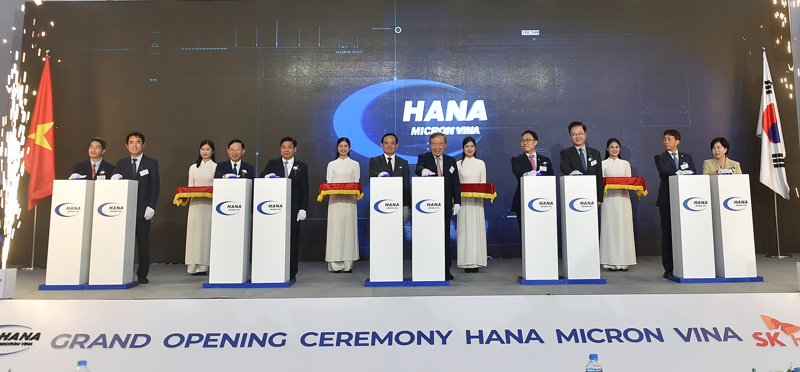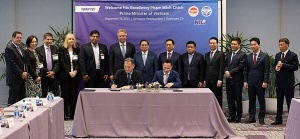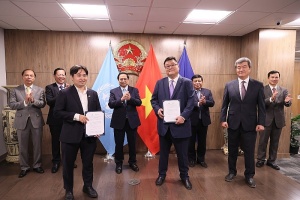NIC propels ahead with semiconductor agreements
During last week’s working trip by Prime Minister Pham Minh Chinh to the United States, the National Innovation Centre (NIC) under the Ministry of Planning and Investment (MPI) signed agreements with US partners to maximise the potential of Vietnam’s semiconductor industry.
| NIC propels ahead with semiconductor agreements, illustration photo/ Source: freepik.com |
In recent times, Vietnam has been focusing on developing human resources, building preferential policies, and crafting incentives for digital economic development, renewable energy, semiconductors, high-tech parks, and innovation and financial centres.
Of these, Synopsys, a Californian semiconductor design software and security group, will provide training licences which include curriculum, educational resources, and other initiatives to the NIC to help set up its chip design incubation centre.
Robert Li, Synopsys sales vice president for Taiwan and South Asia, said, “The successful development of the semiconductor industry requires teamwork and collaboration among government, technological universities, research institutes, and entrepreneurs. We will work closely with the NIC to help fortify Vietnam’s semiconductor industry development.”
Electronic systems design group Cadence will offer access to its tools to academic institutes selected by the NIC, providing students with an opportunity to gain real-world experience creating integrated circuit (IC) designs.
There are several aspects of the collaboration that will benefit the local market in Vietnam. For example, local university students and professors will have access to Cadence support and an online training suite. Cadence will also introduce internship and job opportunities to Vietnamese engineers trained at the NIC.
In parallel, Cadence will introduce the NIC to governments, organisations, businesses, and corporations in the semiconductor industry in the US and around the world.
“We are committed to putting our tools in the hands of next-generation innovators around the world, and this latest collaboration with the NIC fosters chip design advancement in Vietnam,” said Michael Shih, corporate vice president of sales for Asia-Pacific and Japan at Cadence. “The NIC has a pivotal role in the region, and we look forward to working together to ensure engineers have the resources they need to gain practical experience and enable our customers to achieve design success,” he added.
Meanwhile, the Arizona State University (ASU) will introduce job opportunities for Vietnamese engineers trained at the NIC IC design centre for training and incubation with domestic and foreign businesses in the semiconductor industry, including linkages to Arizona’s large global semiconductor ecosystem.
The ASU and the NIC will work with public and private Vietnamese academic institutions and others in order to develop training programmes, research exchanges related semiconductor and related fields.
The ASU will facilitate partnerships with governments, organisations, businesses, and corporations in the semiconductor industry in the US and around the world to support the ASU-NIC collaboration so as to develop the Vietnamese semiconductor ecosystem and deeply participate in the global semiconductor supply chain.
Also, the ASU will explore appropriate funding sources directed to develop workforce capabilities in semiconductors including, but not limited to, those related to the US CHIPS and Science Act.
Both sides will also explore opportunities to link bilaterally the ASU Innovation Zones across Phoenix, Arizona with the NIC in Hanoi to foster US and Vietnamese startup and innovation semiconductor ecosystems.
“The US recognises Vietnam’s potential to play a critical role in building resilient semiconductor supply chains. A newly signed deal between the NIC and the ASU will further develop Vietnam’s current semiconductor and innovation ecosystem, workforce and other related disciplines needs,” said Vo Xuan Hoai, vice director of the NIC.
“The NIC is focused on advancing the Vietnamese innovation ecosystem, driving growth in high-tech areas like the semiconductor industry that can fuel our local economy.”
In Vietnam, the NIC is establishing the infrastructure for the IC design incubation centre at Hoa Lac High-Tech Park in Hanoi, where academic institutes selected by the NIC can leverage Cadence’s portfolio of industry-leading technology to create a wide variety of designs, including 5G, Internet of Things, AI, and 3D-IC packaging.
Minister of Planning and Investment Nguyen Chi Dung said, “Vietnam has enough capacity to develop the semiconductor industry, a political system that is considered stable, and a favourable geographical location.”
Various ministries have been tasked with developing an action programme to improve human resources, with the goal of taking on 50,000 engineers for the industry by 2030.
 | Hana Micron Vina launches pioneering semiconductor factory in northern Vietnam Deputy Prime Minister Tran Luu Quang launched the Hana Micron Vina semiconductor plant in Bac Giang, a pioneering project with future plans to invest over $1 billion and create 4,000 jobs by 2025. |
 | FPT Corporation focuses on AI and chip expansion FPT Corporation has reported orders nearing 70 million chips by 2025 and is setting its sights firmly on the expansion of AI, according to Reuters. |
 | Synopsys to bolster semiconductor development in Vietnam US semiconductor-maker Synopsys has inked deals with Vietnamese partners to advance semiconductor development in Vietnam. |
| Semiconductors a future key industry of Vietnam To maintain a high growth rate of exports, it was necessary to target new trends, including semiconductors, said experts. |
 | FPT Semiconductor and Silvaco forge business partnership Vietnam's FPT Semiconductor JSC is teaming up with US-based Silvaco to enhance human resources development in the semiconductor sector, with plans to establish a training centre in Vietnam and expand business in advanced tech areas. |
What the stars mean:
★ Poor ★ ★ Promising ★★★ Good ★★★★ Very good ★★★★★ Exceptional
Related Contents
Latest News
More News
- Global partnerships key to Vietnam’s IFC development (December 26, 2025 | 16:18)
- Vingroup pulls out of bid to invest in North-South high-speed railway (December 26, 2025 | 11:42)
- Strengthening supply chains through trade promotions and customs reform (December 24, 2025 | 14:00)
- PM orders investment model for North–South high-speed rail (December 22, 2025 | 17:43)
- LS Eco Energy to invest in Vietnam rare earth sector (December 22, 2025 | 17:31)
- Government moves to establish International Financial Centre (December 21, 2025 | 21:00)
- Vietnam's IFC to target global investment flows (December 21, 2025 | 18:00)
- Two national hospitals expand capacity with new facilities (December 20, 2025 | 09:00)
- Ha Tinh breaks ground on major Vingroup industrial and energy projects (December 19, 2025 | 18:24)
- EVN launches major power infrastructure projects nationwide (December 19, 2025 | 18:17)

 Tag:
Tag:


















 Mobile Version
Mobile Version